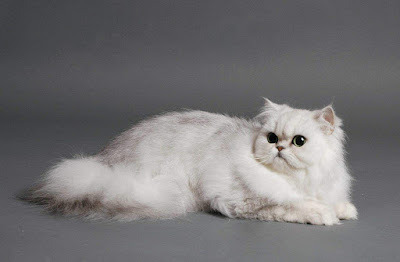There are 8 types of cats you can see here :
Persians
"The Persian is a longhaired cat characterized by its round face and shortened muzzle. Its name refers to Persia, the former name of Iran, where similar cats are found. Recognized by the cat fancy since the late 19th century, it was developed first by the English, and then mainly by American breeders after the Second World War. In Britain, it is called the Longhair or Persian Longhair."
From Wikipedia, the free encyclopedia
Angoras
"The Angora has a very different coat, consisting of long, soft hair, hanging in locks, inclining to a slight curl or wave on the under parts of the body. They have more wedge-shaped head than Persians."
From Wikipedia, the free encyclopedia
Traditional Persian Cat
"The Traditional Persian cat @ Doll Face Persian is considered as a true breed of persian cat. This breed did not change its physical appearance but some breeders in America and other parts of the world started to interpret the standard differently."
From Wikipedia, the free encyclopedia
Peke-face & Ultra-typing
"In the late 1950s, a spontaneous mutation in red and red tabby Persians gave rise to the peke-faced Persian, named after the flat-faced Pekingese dog. It was registered as a breed by the CFA but fell out of favor by the mid 1990s due to serious health issues. In fact, only 98 were registered between 1958 and 1995. Despite this, breeders took a liking to the look and started breeding towards the peke-face look.."
From Wikipedia, the free encyclopedia
Himalayan
"In 1950, the Siamese was crossed with the Persian to create a breed with the body type of the Persian but colorpoint pattern of the Siamese. It was named Himalayan, after other colorpoint animals such as the Himalayan rabbit. In the UK the breed was recognized as the Colorpoint Longhair. The Himalayan stood as a separate breed in the US until 1984, when the CFA merged it with the Persian, to the objection of the breed councils of both breeds. Some Persian breeders were unhappy with the introduction of this "hybrid" into their "pure" Persian lines."
From Wikipedia, the free encyclopedia
Exotic Shorthair
"The Persian was used as an out-cross secretly by some American Shorthair (ASH) breeders in the late 1950s to "improve" their breed. The hybrid look gained recognition in the show ring but other breeders unhappy with the changes successfully pushed for new breed standards that would disqualify ASH that showed signs of hybridization. Because of the regular use of Persians as outcrosses, some Exotics may carry a copy of the recessive longhair gene. When two such cats mate, there is a one in four chance of each offspring being longhaired. Ironically, longhaired Exotics are not considered Persians by CFA, although The International Cat Association accepts them as Persians. Other associations register them as a separate Exotic Longhair breed."
From Wikipedia, the free encyclopedia
Toy & Teacup Persians
"The generic terms are "toy" and "teacup" Persians (terms borrowed from the dog fancy), but the individual lines are called "palm-sized", "pocket", "mini" and "pixie". Currently none are recognized as breeds by major registries and each breeder sets their own standards for size."
From Wikipedia, the free encyclopedia
Chinchilla
"In the USA, there was an attempt to establish the Silver Persian as a separate breed called the Sterling, but it was not accepted. Silver and Golden longhaired cats, recognized by CFA more specially as Chinchilla Silvers, Shaded Silvers, Chinchilla Goldens, or Shaded Goldens, are judged in the Persian category of cat shows. In South Africa, the attempt to separate the breed was more successful; the Southern African Cat Council (SACC) registers cats with five generations of purebred Chinchilla as a Chinchilla Longhair. The Chinchilla Longhair has a slightly longer nose than the Persian, resulting in healthy breathing and less eye tearing. Its hair is translucent with only the tips carrying black pigment, a feature that gets lost when out-crossed to other colored Persians. Out-crossing also may result in losing nose and lip liner, which is a fault in the Chinchilla Longhair breed standard. One of the distinctions of this breed is the blue-green or green eye color only with kittens having blue or blue-purple eye color."








